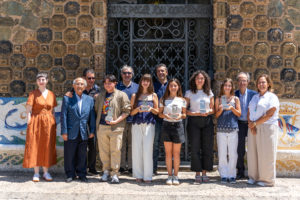January 30, 2019

In one of the mosaics of Bellesguard we can see the silhouette of Montserrat. The relationship of this unmistakable Monte with the Tower is much narrower than it seems at first glance. There are several links that tell you:
The end of the royal lineage of the house of Barcelona
The death without an heir of Martin I poured the Crown of Aragon into a dynastic crisis of serious consequences for Catalonia. Four symbols represent this crisis on the mosaic of the west side of the tower: the silhouette of Montserrat, which incarnates Catalonia, the date of 1410 in roman numbers, the year in which died Martin I, the last monarch of the House of Barcelona, and some clouds, or fog, signs of “bad times”. Finally, the sun behind Montserrat in the west corner of the house corresponds to the sunset, which reinforces the theme of the end of the lineage of King Martin I.
The desire to have an heir
In order to prevent the defeat that led to the death of Martin I without an heir, the monarch married Margarita de Prades in a desperate attempt to have new offspring (his only son, Martin the Younger, had died in Sardinia shortly before, as well as his mother and first wife of the king). The ceremony of the second marriage took place at Bellesguard short after the pilgrimage of the young engaged to Montserrat to ask the Virgin an heir to the crown. Unfortunately, this visit did not get any results.
The abbot dignity of Montserrat
On March 10th 1409, the priory of Montserrat was elevated to the status of abbey, with the name of Santa Maria de Montserrat, thanks to a bull of Benedict XIII, better known as “Papa Luna”. At the end of June this year, King Martin began to reside at Bellesguard. Shortly after, Benedict XIII, advised by King Martin, appointed the first abbot to Marc de Vilalba, and then Margarita de Prades, as we have already said, went to the recently opened abbey to request a new heir. Shortly thereafter, already residing at the Bellesguard Palace, Benedict XIII attended the king’s marriage with Margarita de Prades, held on December 17th.
Sadly, on June 18, 1410, Benedict XIII had to return to Bellesguard for a very different reason: the burial of King Martin without an heir. After the funeral he visited Montserrat. Josep Miquel Bausset, the current monk of Montserrat, reminds us that: “Apart from the abacial dignity granted to Montserrat, Benedict XIII showed himself comprehensive and magnanimous with the sanctuary, enriched by him with a series of thanks and privileges, such as the grant of indulgences to the faithful who visited him or helped him with alms or the permission that he gave to the monks and predecessors to administer the sacraments, without any other requirement than the venia of the local superior. ”
The devotion of Gaudí and Jaume Figueras for the Virgin of Montserrat
Jaume Figueras, the client who commissioned Bellesguard Tower, his brother, the painter Francesc Figueras, and Gaudí himself, were members of the Spiritual League of the Virgin of Montserrat. This group was founded in 1899, one year before the beginning of the construction of the Bellesguard Tower, by the bishop Josep Torras i Bages, one of the great friends of Gaudí (among his last projects highlights the erection of a great monument for this bishop at the Sagrada Familia). The purpose of the League was to enrich the Christian life of the associates and promote the spiritual and temporal reconstruction of Catalonia. It is not surprising, then, that at Bellesguard’s main door we can read a clear allusion to the Virgin: “Ave María Puríssima concived without sin.”
It is also revealing that Gaudí wanted to participate in the restoration of Montserrat, although, unfortunately, his projects were frustrated for several reasons. Only the so-called First Mystery of Glory was made, one of the first initiatives of the Spiritual League of the Virgin of Montserrat. The architect was commissioned by this mystery in 1900, the same year that Jaume Figueras commissioned the construction of Torre Bellesguard. Unfortunately, like the projects of Gaudí in Montserrat, the realization of the Bellesguard Tower suffered a series of problems, leaving the work incomplete in 1909. In fact, the realization of the mosaic with the silhouette of Montserrat mountain was carried out in 1916 by Domènec Sugrañes i Gras, one of the most brilliant disciples of Gaudí.




